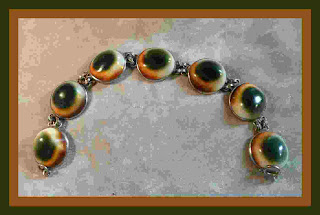Themed Collections
Butterflies, part 1

Many collectors of Vintage Costume Jewellery prefer to stick to one theme.
It may be to collect brooches, necklaces, bracelets or earrings. Perhaps parures or demi-parures (matching sets or half sets). Some collect any item with the same theme. It could be cats, insects (see the butterflies above).
The butterflies pictured are part of my collection and range from the early part of the 20th century to fairly modern. Some can be worn as either a brooch or a pendant, having both a pin and a bale for use with a chain.

This butterfly has mesh wings and is gold plated. It belongs to a group called 'en tremblant'. The upper wings are attached with small spring-like devices which let them tremble as if flapping as the wearer moves.
These 3 small brooches measure no more than 2 cm each. From the left - base metal and rhinestones (1910-1930), centre - silver filigree (?Edwardian) right - carved mother of pearl with 6 brilliant stones (?1930's)







a2b.jpg)